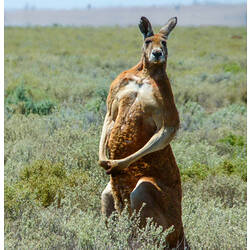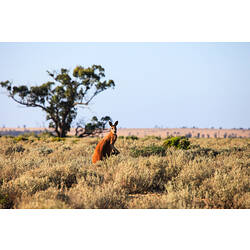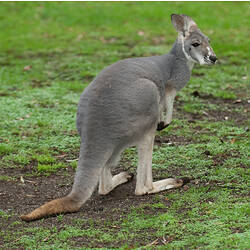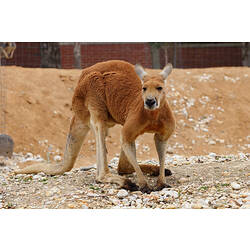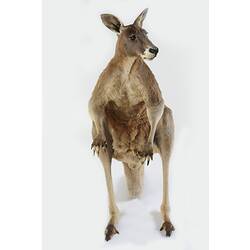General Description
Male body fur red-brown, paler on the legs, arms, face and tail. Female body fur blue-grey, paler underneath. Wide white stripe on face. Male body up to 1.4 m, tail up to 1 m. Female body up to 1.1 m, tail up to 90 cm.
Biology
Red Kangaroos are the world's largest living marsupial, but at birth, like all Kangaroos, they are only about the size of jelly beans and not very developed. The blind, hairless baby Red Kangaroo (known at this stage as a neonate) will crawl into its mother's pouch where it develops further before emerging months later as a joey. A female Red Kangaroo can have up to three young in varying stages of development if conditions are favourable: one in her pouch; a more independent, though still-suckling joey, out of the pouch; and an embryo that will emerge into the pouch when its older sibling moves out. Breeding does not occur in times of drought. Red Kangaroos are active from dusk until dawn in small groups, but often feed in larger groups (mobs). They are considered pests by some farmers because they compete with stock for grass.
Distribution
Arid areas of interior mainland Australia.
Habitat
Arid areas, grasslands, woodlands and shrublands.
More Information
-
Animal Type
-
Animal SubType
-
Brief Id
White stripe on face, red or grey fur.
-
Colours
Red, Grey
-
Maximum Size
1.4 m
-
Habitats
-
Where To Look
-
When Active
Nocturnal, Diurnal
-
Diet
Herbivore
-
Diet Categories
Grasses, Herbs
-
Endemicity
-
Conservation Statuses
CITES: Not listed, FFG Threatened List: Not listed, EPBC Act 1999: Not listed, IUCN Red List: Least Concern
-
Taxon Name
-
Common Name
Red Kangaroo
-
Kingdom
-
Phylum
-
Subphylum
-
Class
-
Superorder
-
Order
-
Suborder
-
Family
-
Subfamily
-
Genus
-
Species Name
rufus

